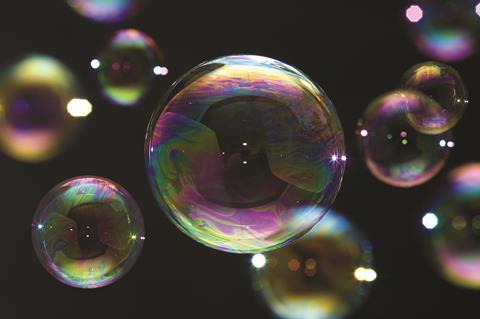In this article from the ‘Avogadro’s lab’ series, Stephen Ashworth looks at the colourful chemistry of bubbles and experiments with soap films
Have you ever wondered why a film of oil on a puddle appears to have many different colours even when the oil has no colour? It is all to do with the way light reflects from the oil.
Bending light
If you look through a window you can usually see a weak reflection. That means the glass is partially reflecting, acting like a mirror for some light, but not all of it. This happens where two materials which bend light different amounts (different refractive indices) meet.

The top surface of the oil, which is in contact with air, is acting like a window and reflecting some light, but so is the bottom surface of the oil. So the light that reaches your eye from the bottom surface travels a little further than the light reflecting from the oil/air interface.
The light from the two reflections interact when they overlap. If the extra distance that some light travels is equal to any whole number of wavelengths (one, two etc.) you only see light of that wavelength (colour). (This is not always true – in some cases it is one and a half, two and a half wavelengths etc. It depends on the relative sizes of the refractive indices of the two materials at the interface.)
This happens because only these waves add together (constructive interference), all the other wavelengths cancel out (destructive interference). At each angle the extra distance the light travels through the oil layer will be different, which means you see different colours in different places.
The same principle is used to make high reflectivity mirrors and filters that only let certain wavelengths or ranges of wavelengths through. Thin layers of materials like SiO2 and MgF are used rather than oil. By changing the thickness of the layers, anti-reflection coatings which are used on spectacles, as well as other optics, can be made.
Colourful bubbles
A soap bubble is a thin layer of water with air on both sides and the same effect produces colours in these bubbles. The colours change when gravity drains water out of the film towards the bottom of the bubble and the film thins at the top. If you are careful, you can see an extreme case of this by setting up a single soap film and letting it drain. At the top the film will become so thin that destructive interference occurs for all visible light wavelengths so the film appears black.
Try it yourself
First make a soap mixture using water, washing-up liquid and a little glycerine; you might need to experiment to get the best mixture. Make a frame for your soap film by threading a piece of cotton string (try 50 cm) through two 10 cm pieces of drinking straw and tying the ends together. Dip the whole thing in your bubble solution and by holding the straws as far apart as possible form a soap film in a rectangular frame. By holding the straws, or better still fixing them in some way (such as with kebab skewers along the length of the inside of the straw) you will be able to leave the soap film undisturbed while the water drains out. The film will thin at the top first so you should see the black area slowly move downwards when it forms.
When you have finished you have a great frame for making super big bubbles. Just form a film and holding the two straws, move it through the air.
Find out more
For enthusiasts, this Wikipedia article gives you lots more information about thin films, including the maths!
For enthusiasts, this Wikipedia article (http://bit.ly/11gCNbs) gives you lots more information about thin films, including the maths!
Additional information
This article originally appeared in The Mole, the student magazine published by the Royal Society of Chemistry from 2012 to 2015.









No comments yet